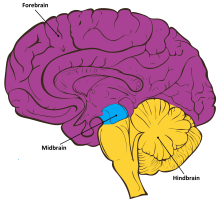The brain


The brain is a complex organ which controls: thoughts, memory, emotion, touch, motor skills, vision, temperature, hunger and every process that controls our body. The central nervous system is made of: the brain and the spinal cord.
How does it work?
The brain receives chemical and electrical signals throughout all our body. Each signal controls a different process, and the brain interprets the signals. This signals alert our brain, like for example the pain. Some messages are kept within the brain, and others are relayed to the distant extremities (for this the the nervous system has nerves).
The structure of the brain.
It is divided in three units: the forebrain, the midbrain and the hindbrain.
- Forebrain: It is the largest region of the brain. Inside the cerebrum, it happens important functions of the brain, like thinking, planning, reasoning, language processing and interpreting. It is divided in four lobes (frontal, parietal, occipital and temporal).
-Midbrain: It serves as a vital connection point between the other major regions of the brain - the forebrain and the hindbrain.
-Hindbrain: It's one of the most important parts of the entire nervous system because it connects the brain with the spinal cord. Most of the cranial nerves are in it.

The blood.
The vertebral arteries and the carotid arteries supply the brain with blood. The blood allows the brain to get oxygen and nutrients, so it can work.
Bibliography:
https://www.hopkinsmedicine.org/health/conditions-and-diseases/anatomy-of-the-brain
https://qbi.uq.edu.au/brain/brain-anatomy/forebrain
https://qbi.uq.edu.au/brain/brain-anatomy/midbrain
https://qbi.uq.edu.au/brain/brain-anatomy/hindbrain
https://www.ncbi.nlm.nih.gov/books/NBK538134/#:~:text=The%20blood%20flow%20in%20the,pressure%20in%20the%20body%20changes.
Comentarios
Publicar un comentario